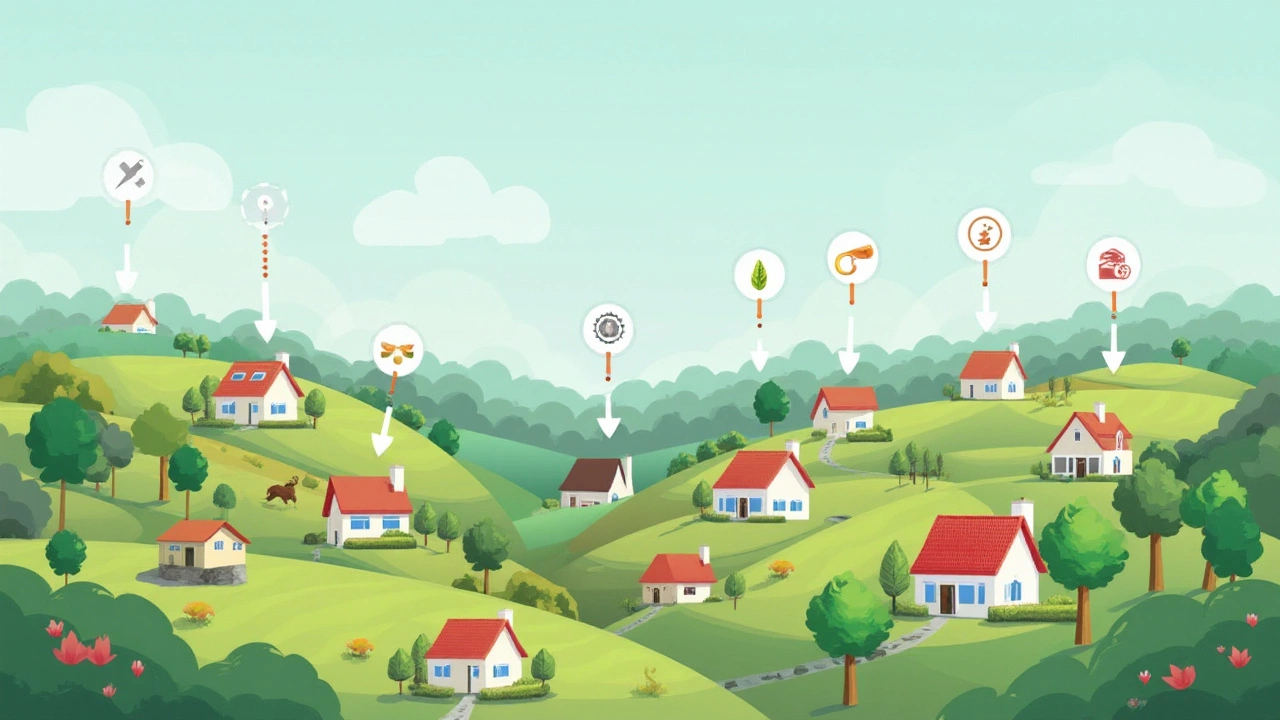Homeowners insurance acts like a guardian for your house, safeguarding you from unforeseen mishaps. But with so many companies vying for your attention, each claiming to be the best, where do you start to find a policy that won't break the bank? It's crucial to understand what influences the price of home insurance and to know how to compare different offers wisely.
By exploring these factors, you can unlock ways to snag a deal that fits your budget. With a little guidance, finding a balance between cost and protection becomes less of a chore and more of an informed choice. Remember, getting affordable homeowners insurance is not just about picking the cheapest option, it's about knowing what you need at a price you can afford.
- Understanding Homeowners Insurance
- Factors Affecting Insurance Costs
- Shopping for Affordable Policies
- Tips to Lower Your Premium
Understanding Homeowners Insurance
Homeowners insurance, at its core, is designed to provide financial protection for your home and personal belongings if bad things happen, like a fire or burglary. It's part of owning a home, just like paying property taxes or keeping the lawn mowed, but it’s there to make sure you can bounce back when life throws you curveballs. While it may sound simple, the details of what's covered and what's not can be a bit murky if you're not paying attention.
Most standard policies cover four main areas as their foundation: your dwelling, other structures, personal property, and liability protection. The dwelling coverage is perhaps the most significant, as it covers damage to the actual structure of your home. This means if a storm rolls through and rips the roof tiles right off, your insurance can help with the repairs. Coverage typically extends to other structures on your property as well, such as garages, tool sheds, or even that cozy little gazebo you might have in the backyard.
The Intricacies of Policy Limits and Deductibles
Understanding policy limits is crucial. This is the maximum amount an insurance company will pay out for a covered loss. For instance, if you have $250,000 dwelling coverage and a fire causes $300,000 in damages, you would have to cover the remaining $50,000 out-of-pocket. Deciding the right coverage limit isn't just pulling numbers out of a hat though; it's about evaluating the cost to rebuild your house should it be completely destroyed. On the other hand, a deductible is the amount you'd pay before the insurance kicks in to cover a loss. Opting for a higher deductible can lower your premiums, but it also means you'll bear more of the burden should disaster strike.
Liability protection is another corner of homeowners insurance often overlooked. This part protects you from legal claims arising from property damage or bodily injury that you or your family members cause to others. Imagine if your dog decides that barking at the neighbors isn't enough and goes for a nip instead. If someone files a lawsuit over such an incident, your insurance can help with the legal expenses, which, in some cases, can become quite substantial.
According to the Insurance Information Institute, “homeowners insurance is meant to cover unexpected damage, not routine maintenance.”
Your personal property is also covered under most policies. There's a fine line, however, between what's considered 'personal property' and what's not. Generally, the personal stuff like furniture, electronics, and clothes are covered if they’re stolen or destroyed. An important task is to take stock of your belongings. An inventory list can help ensure that you have enough coverage and can speed up the claims process if you ever need to file one.
Specific Riders and Additional Coverage
There are certain limitations to standard homeowners insurance. High-value items such as jewelry, art, or rare collectibles may not be fully covered under a basic policy. Insurance riders or endorsements can be added to cover these high-value items. Additionally, certain kinds of disasters are usually not covered, such as floods or earthquakes. Special policies or additional endorsements are required for them. Recognizing these gaps and addressing them with your insurance agent can save you a lot of trouble later on.
| Type of Coverage | Typical Limitations |
|---|---|
| Jewelry | $1,500 - $2,500 |
| Electronic Equipment | $1,000 - $2,000 |

Factors Affecting Insurance Costs
When it comes to homeowners insurance, several factors can push premiums up or down, turning the quest for affordable insurance into a puzzle. The first piece involves the location of your home. Is it in an area prone to natural disasters like earthquakes, hurricanes, or floods? If so, expect higher rates, as insurance companies see those areas as higher risk. Living in a neighborhood with high crime rates can also spike costs, as the likelihood of theft or vandalism increases. People residing in gated communities, with their added security measures, however, often enjoy lower premiums.
Another significant factor is the age and condition of your home. Older homes, particularly those with outdated electrical and plumbing systems, are considered riskier than newly built homes with modern installations, making the former more expensive to insure. Similarly, homes with existing damage or those that haven’t been well-maintained may incur higher costs as insurers worry about potential claims. On the flip side, making necessary updates to these systems and regular maintenance can qualify you for discounts.
"Your home is one of your most valued investments. It is essential to secure its future by understanding what influences homeowners insurance costs," emphasizes the National Association of Insurance Commissioners.
Adding to the complexity are personal factors such as your credit score. Insurers often use credit-based insurance scores to predict potential claims, and many studies have established a correlation between credit rating and insurance claims. Those with higher credit scores typically pay lower premiums than those with poor credit. Also, the coverage type and limits you choose greatly affect cost. Opting for lower deductibles or adding optional endorsements like personal property coverage, identity fraud protection, or business property coverage for home-based businesses can increase rates significantly.
The size and design of your property play a role too. Larger homes, or those with unique architectural features, custom-built interiors, or valuable materials, tend to require higher coverage limits, translating into pricier premiums. A home's construction materials, like whether it’s built of wood (which is more flammable) versus brick or stone, also impact insurance rates. Houses with a pool, trampoline, or even a dog are viewed as having higher liability risk, which can augment costs. Ultimately, understanding these factors can help you make savvy decisions in your quest to find the most budget-friendly option.

Shopping for Affordable Policies
Choosing the right homeowners insurance can sometimes feel like solving a puzzle with way too many pieces. One of the first things you should do is familiarize yourself with what each policy covers and how much it might cost. Many people think the biggest companies automatically have the cheapest prices, but that's not always true. It's good to shop around and gather quotes from multiple companies before settling on one. The easiest way to start is by using online tools that allow you to compare different insurance plans side-by-side. This can save you a lot of time and effort, helping you avoid the trap of sticking with the first option you find.
When shopping for the most affordable home insurance, consider bundling your policy with other types of insurance you might need, like auto insurance. Many companies offer attractive discounts when you purchase multiple policies from them. For example, according to a study by the Insurance Information Institute, bundling policies can save homeowners up to 25% on their insurance premiums. It’s also wise to inquire about any other available discounts you might be eligible for, such as those for having a good payment history, installing smoke alarms, or even being a non-smoker.
An insightful method to determine the right company is by reading customer reviews and checking an insurer's financial strength. This often flies under the radar during the decision-making process, but it’s crucial. After all, you want to ensure the company can cover you in the event of a substantial loss. Independent agencies like A.M. Best provide ratings that reflect the financial stability of insurance companies.
Consumer Reports suggests, "Consider reliability and service when choosing an insurer; cost isn’t everything." By taking these steps, you lower the risk of encountering unwelcome surprises when filing a claim.
Besides online comparisons, personal endorsements can also be quite valuable. Ask friends or family about their experiences with their insurers. Did they feel the claims process was straightforward? How well did the company handle any disputes that arose? Learning from others’ experiences can shed light on potential red flags that you might otherwise miss. In this process, flexibility is important. Don’t hesitate to reach out directly to insurance agents. They can often tailor the policies to better meet your specific needs, sometimes even offering discounts that aren’t advertised publicly.
If you find yourself overwhelmed by options, consider consulting an independent insurance agent. These professionals aren’t tied to a single insurer, so they can provide unbiased advice and help you pinpoint the best policy for your situation. A bit of professional guidance can clarify complex terms you might not fully grasp on your own. Lastly, remember that securing a budget-friendly policy takes time. Rushing through the process might lead to higher costs down the road, especially if you need to adjust the coverage because it doesn’t quite fit your circumstances. Patience and diligence in research can pay off significantly in finding the perfect home insurance policy.

Tips to Lower Your Premium
When it comes to trimming down your homeowners insurance costs, a clear understanding of what you're paying for can go a long way. Start by reviewing your policy thoroughly. Sometimes, homeowners might pay for more coverage than they actually need. Carefully assessing what each aspect of your policy covers will help you get rid of unnecessary extras. This is just one of the simple yet effective approaches to achieving more affordable homeowners insurance.
Another noteworthy strategy is bundling your policies. Many insurance providers offer discounts if you get multiple insurance types from them. For instance, having both auto and home insurance under the same provider can lead to a significant reduction in your premiums. Similarly, increasing your deductible—the amount you'll pay out of pocket before your insurance kicks in—can substantially lower monthly or annual costs. Just ensure that the deductible is something you can manage comfortably should an incident occur.
Being proactive about home safety can also work in your favor. Installing security systems, smoke detectors, and fire alarms not only protects your home but can also encourage insurers to give you lower rates. Most insurance companies appreciate homeowners who take preventive measures, rewarding them with reductions in premiums. It's wise to discuss this with your provider to understand which safety enhancements they value the most.
There's also merit in maintaining a good credit score. In many cases, insurers consider this when setting premiums. By paying your bills on time and minimizing debt, you could enjoy lower insurance rates. According to the Federal Trade Commission, people with higher credit scores are less likely to file claims, which is why companies take it into account.
The Insurance Information Institute states, "Your credit history can affect what you pay for homeowners insurance. It's a reliable indicator of risk in many cases."
Frequently revisiting your policy and shopping around is equally crucial. Insurance markets aren't static, and prices can fluctuate over time. Comparing different offers every year or two ensures that you’re still receiving the best deal available. Look at the coverage options side-by-side, and don't hesitate to switch if a better option arises. Online comparison tools make this task easier than ever, though speaking with an insurance agent can provide more personalized advice.
